How Often to Bathe a Dog: 56% of Pet Owners Don’t Do It Enough
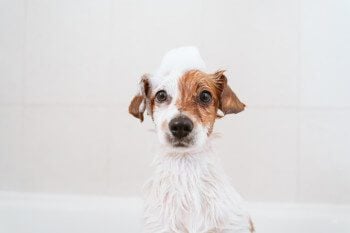
Table of Contents
Let’s face it, bath time can be frustrating for all parents — even pet parents.
Bath time and other regular hygiene routines for dogs can be a hassle, and some dogs can become nervous or agitated when it’s time for a good old scrubbin’.
While baths, nail trims, and ear cleanings may seem tough at times, they’re all necessary parts of a healthy routine for your fur baby. Not to mention, failing to keep up proper grooming can have some serious effects. So grab some peanut butter to lure in your fur baby and get ready for a bath!
We polled 322 American dog owners in an online survey to get the details on how often they groom their fur babies. Here are the surprising results.
Key Findings:
- 56% (or Over Half) of Pet Parents Don’t Bathe Their Dogs as Frequently As They Should
- 60% of Pet Parents Use the Sniff Test When Deciding to Bathe Their Dog
- 95% of Pet Parents Bathe Their Dogs at Home
- Only 24% of Pet Parents Experience No Frustrations When Bathing a Dog
- 33% of Pet Parents Experience the Most Frustration Keeping their Dog Still and Calm During a Bath
- Less than 10% of Pet Parents Trim their Dog Nails as Frequently as They Should
- Only 27% of Pet Parents Clean their Dogs’ Ears as Frequently as They Should
56% of Pet Parents Don’t Bathe Their Dogs as Frequently As They Should
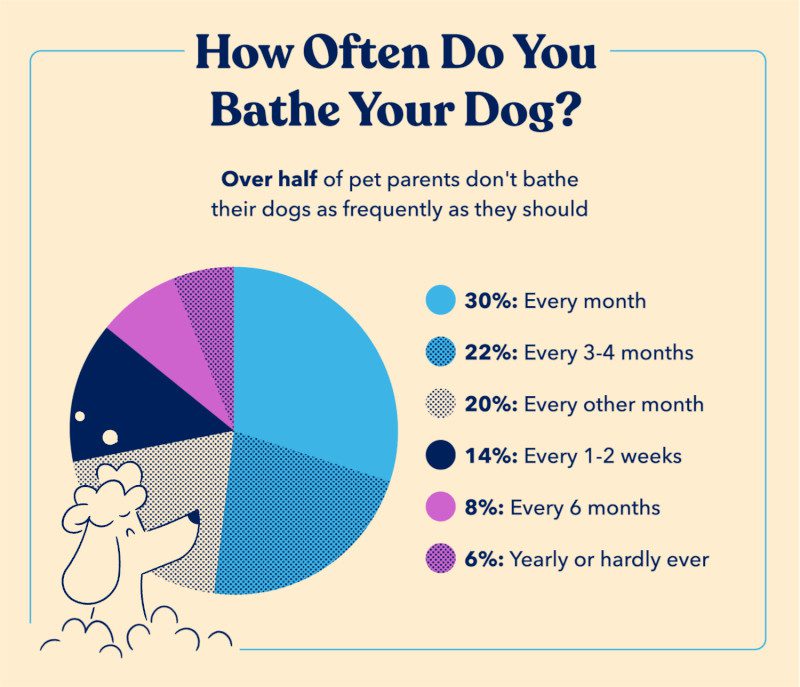
Our findings showed that over half of dog owners don’t bathe their dogs as regularly as they probably should.
Which leads us to the question, how often should you wash your dog? Should they be bathed once a week? Twice a month? Every day like their human companions? The answer’s a bit more complicated.
How Often to Bathe a Dog
While the frequency a dog should be bathed truly depends on their physical activity level along with the physical characteristics of each dog, the general rule of thumb is simpler.
According to Petco’s Manager of Pet Services Grooming Education, Wendy Weinand, you should wash your dog once every four weeks. This ensures that their skin and coat are clean, and free from harmful microorganisms and debris.
Giving your dog a bath once a month will help to keep skin, fur, paws, and ears free of filth and infection. But how can you tell if your doggo needs a bath before the estimated four-week mark?
60% Pet Parents Use the Sniff Test When Deciding to Bathe Their Dog
Our good old-fashioned sense of smell tells us whether something is clean or not so clean. While some might disagree on what smells constitute as “clean” or “pleasant”, we can all agree on one thing—a dirty dog stinks.
With the Petri combination plate of bacteria, fungi, and other nasty stuff on Fido’s skin and fur, there’s going to be a whirlwind of stank emanating from your dog.
Stank, of course, being the very technical and scientific term for the odor that is wet dog and filth.
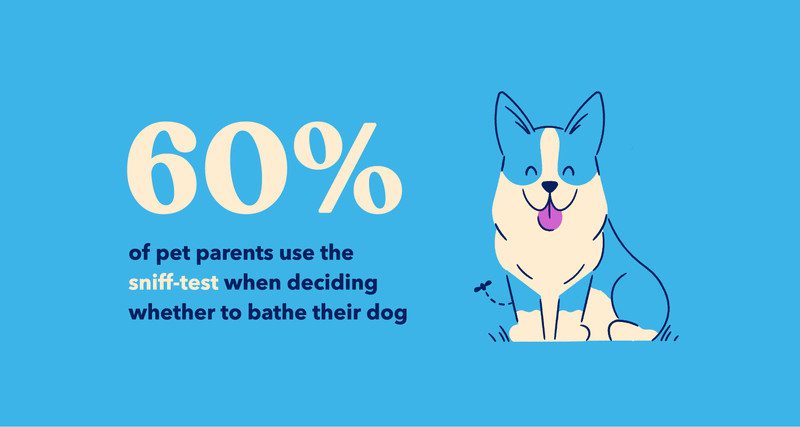
Even if your dog isn’t particularly stinky, if they are especially active outdoors or have certain features making them prone to bacteria (think flat faces or floppy ears), bathing more frequently is always a good idea.
If your nose does detect some stank on your dog, it’s time to get to grooming. Luckily, bath time doesn’t have to be a pricey or time-consuming affair. While a professional groomer is great for sensitive or particularly hairy breeds like Bichons or Poodles, you can save some bucks and bathe your pooch at home.
95% of Pet Parents Bathe Dogs at Home
For people with older or sensitive dogs who don’t like to be groomed, regular hygiene may look like an extreme sport of dog herding. However, most pet parents are very comfortable washing their dogs right in the comfort of their own homes. In fact, only 5% of pet parents leave grooming their fur babies to a professional.
Luckily, dogs who do need a bit more TLC have the option to be taken to special dog grooming and care centers to be washed by professionals who have the necessary tools and experience to handle these dogs. So relax, you can put down the dog Benadryl!
Because it isn’t easy, many dog owners seemingly avoid bathing their dogs for as long as possible. While having a dirty dog every now and again is a-ok, failing to regularly bathe your dog isn’t good for their health.
And if time is the constraint, a quick rinse under the hose is better than nothing.
How Dirty Are Dogs?
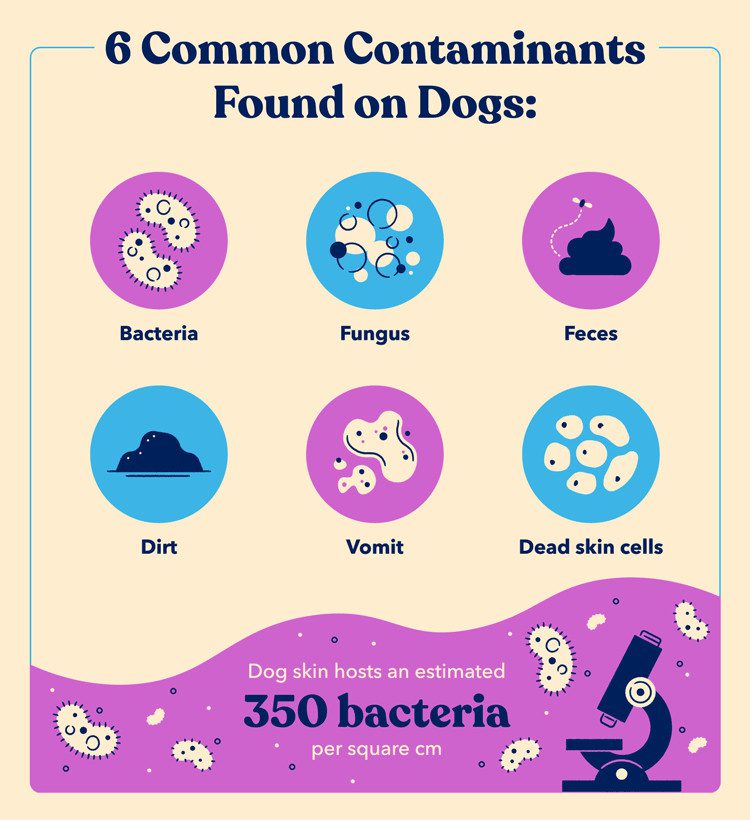
If it’s been over two or three weeks since you last washed your dog, then there’s no doubt that your doggo is dirty. But the question is,howdirty?
To understand exactly what invisible organisms we’re sharing the living room couch with, we’ll be looking at bacteria, fungi, debris, dirt, and other common types of gross contaminants commonly found on Fido.
Common Bacteria Found On Dogs
Studies show that a dog’s skin hosts an estimated 350 bacteria per square centimeter. Yes, that’s per centimeter.
From the skin and tabletops to toilet seats and toenails, bacteria can be found living almost everywhere. And thanks to technology and some super powerful microscopes, researchers have been able to identify some of the most prevalent microorganisms living on your dog’s skin.
Due to bacteria’s pervasiveness, pets can easily come into contact with them, bring them into the home, and contaminate their environment.
Be sure to clean dog toys, beds, and other items regularly to avoid supplying a perfect habitat for bacteria to grow.
Some of the common bacteria that can affect dogs are:
- Salmonella
- Leptospirosis
- Campylobacter
- Helicobacter
- Streptococcus
- Clostridia
- Bordetella
- E Coli
Common Fungus Found On Dogs
Right next to the pesky bacteria species affecting dogs are the fungi family. Fungi are nature’s microscopic decomposers and are living all around us. They can be found on our bodies, in the soil, in the air, and yes, living on your dog.
While some fungi are beneficial for food and industrial purposes, others are pathogenic and can affect a dog’s immune system. Certain infections affect your dog’s internal organs, while others are localized and only affect small areas of skin.
Some common fungi species that can harm canines are:
- Aspergillus
- Candida albicans
- Coccidioides immitis
- Cryptococcus neoformans
- Cryptococcus gattii
- Geotrichum candidum
- Histoplasma capsulatum
- Blastomyces dermatitidis
Other Gross Stuff Found On Dogs
In a disgustingly fascinating study, the TV screens and pillowcases of dog-owning families were shown to have 52% and 42% more microbial groups, respectively, than those of non-dog-owning families. Yuck. Here are some other nasty things frequently found on Fido:
- Feces
- Vomit
- Dirt
- Dead skin cells
- Food particles
- Gum or other sticky candy
Only 24% of Pet Parents Experience No Frustrations When Bathing a Dog
Now that you have a clear understanding of how easily your pretty pooch can become a filthy animal, there can only be one solution to this menacing problem…
Wash, scrub, repeat!
With a little soap and a lot of water, your pooch is going to be looking good as a new puppy in no time…or are they?
While 95% of owners bathe their pups at home, only 24% of them experience no frustrations when bathing a dog.
That means the majority of dog-owners are struggling with giving their dog a bath.Maybe that’s why nobody’s doing it enough!
33% of Pet Parents Experience the Most Frustration Keeping their Dog Still and Calm During a Bath
Nobody likes backyard wrestling a stinky wet dog to try and keep them still for a scrub down— especially when your only weapons are a hose and a sponge.
It’s not hard to believe that 33% of pet owners find keeping their dog calm and still to be the biggest challenge during bathtime.
While bathing post playtime might wear out certain dogs enough so that they’re all out of energy to fight a bath, other dogs might need some more help.
Consider using CBD dog treats. The naturally soothing ingredients should help to make bath time more tolerable for both of you.
Dog Grooming is More Than a Bath
So you finally got Fido to sit still for his monthly bath. Now he’s all groomed and good to go….Right? Wrong.
Just like people, keeping your pet clean and healthy does not simply mean scrubbin’ in the shower. A healthy grooming routine should also include nail trims and ear cleanings.
According to our survey data, most pet parents aren’t on top of regular grooming.
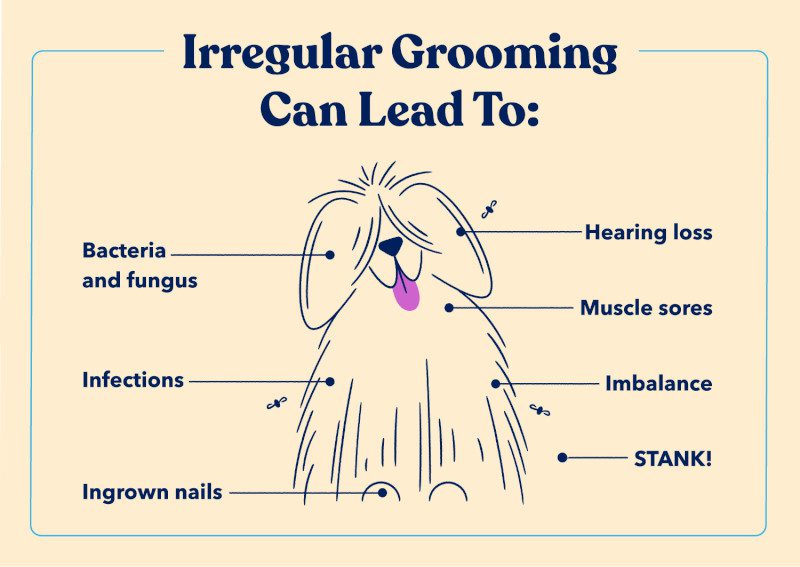
Less than 10% of Pet Parents Trim their Dogs Nails as Frequently as They Should
How often should dogs have their nails trimmed? Nail trimming is a very important grooming process that’s beneficial not only to protect you from unnecessary scratches but to keep your pet healthy. Ideally, a doggo’s nails should be trimmed every 3 to 4 weeks.
However, if you’re regularly walking them on cement or other hard surfaces, that amount may be less, due to the natural grinding of the nails.
What Happens When Dog Nails are Left Untrimmed?
If you’ve ever wondered why nail trimming is such a big deal, remember that dogs are believed to have evolved from the gray wolf, Canis lupus. Having them running around with long nails should frighten you a little. Overgrown nails can result in the following issues:
- Can lead to painful ingrown nails
- Can provide a haven for bacteria to thrive
- Can prevent dogs from balancing their weight properly when standing
- Can lead to sore feet, along with pains in the legs and hips
- Unexpected scratches on pet parents and other pets
Only 27% of Pet Parents Clean their Dogs’ Ears as Frequently as They Should
Apart from bathing and nail trimming, another important thing to do when grooming your dog is to clean their ears. Surprisingly, over 25% of dog owners admit to rarely cleaning their dogs’ ears. Talk about stinky!
What Happens When Dog Ears are Not Cared For?
Ear cleaning is an integral part of a dog’s grooming process, but why is cleaning and caring for your dog’s ears so crucial? Here’s a list of things that could happen when your dog’s ears are not cleaned:
- Wax build-up and infection: Ear wax is beneficial for keeping the ear clean and moist. But when it’s secreted in excess and accumulates over time, it provides a suitable environment for bacteria to grow and infect the ear.
- Hearing damage: This is the ultimate result of the accumulation of debris in the ear canal that could rupture the eardrum.
With those effects in mind, it’s easy to understand why it’s critical to clean your pup’s ears at least once a month, and even more frequently if they have big floppy ears or are especially active outdoors.
5 Simple Tips to Make Grooming Your Pup Easier
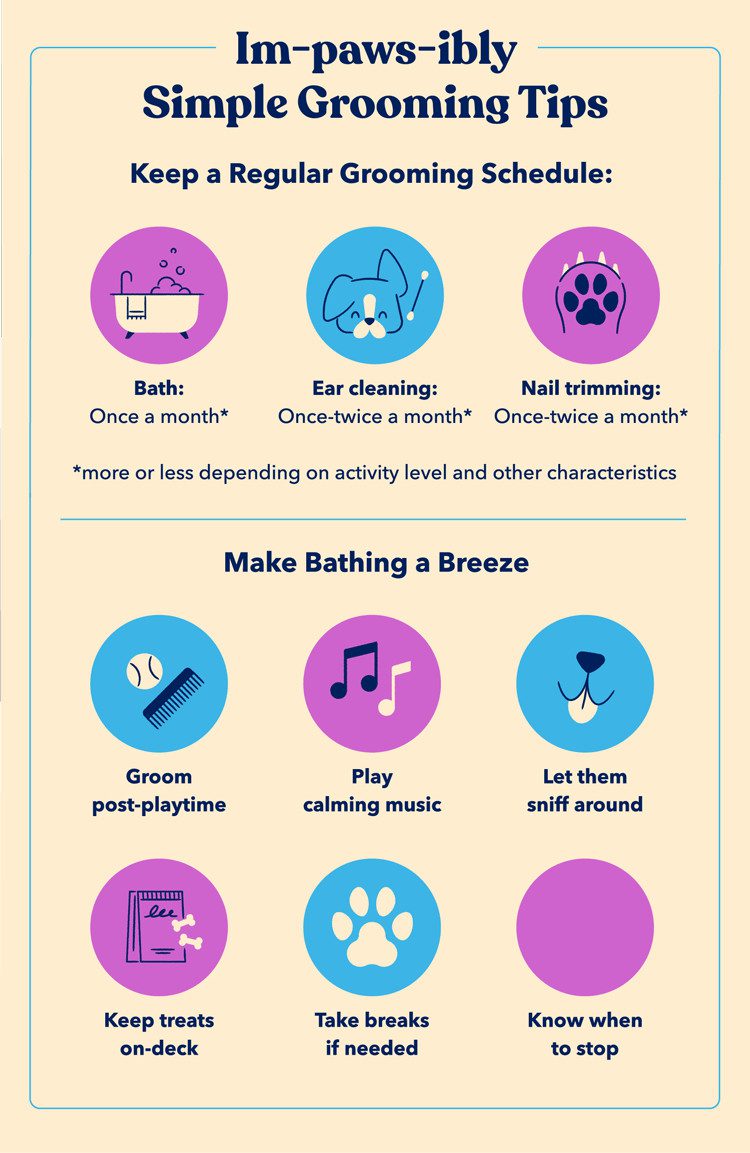
With proper bathing, washing, nail trimming, and ear cleaning, Fido will beso fresh and so cleanin no time.
To wrap things up, here are a few tips to make grooming your dog easier.
- Ease your dog into being familiar with the grooming space. Do this by letting him explore the room to be a little more comfortable with his environment.
- Use an all-in-one wash. Don’t make things harder and try to use a bunch of different specialized shampoos and soaps on Fido in the bath. Try products like this 5-in-1 wash that cleans, conditions, deodorizes, moisturizes, and detangles all at the same time. What more do you need?
- Always try to groom your dog after playtime. That way, he has used up most of his pent-up energy and is in a happy mood.
- Take necessary breaks.While it may seem instinctive to push through to finish the bath, if your dog is having a terrible time and won’t calm down, consider stopping. While a stinky dirty dog isn’t the best, we want to be empathetic to our fur friends and be careful not to traumatize them, making future baths a nightmare.
- Reward your dog for staying calm. Positively reinforcing good behavior should help make future grooming a bit easier. You can even try calming CBD dog treats for those extra anxious around water.
- There’s nothing better than a piece of relaxing music to accompany grooming time.Ensure that you have some music to help soothe not just your fur baby, but you as well!
- Know when enough is enough.Try to keep the grooming session short enough so your dog doesn’t feel worn out. Forcing your dog to do something they’re uncomfortable with may agitate them and make future baths even worse.
Be sure to practice regular bathing and grooming for your dogs to ensure they’re clean and free from disease-causing pathogens all the time. Consistent and thorough care will also help minimize emergency visits to the vet and avoid unnecessary health risks.
Dog hygiene is essential not only to the health and wellness of fur babies but also to our own well-being and safety.















